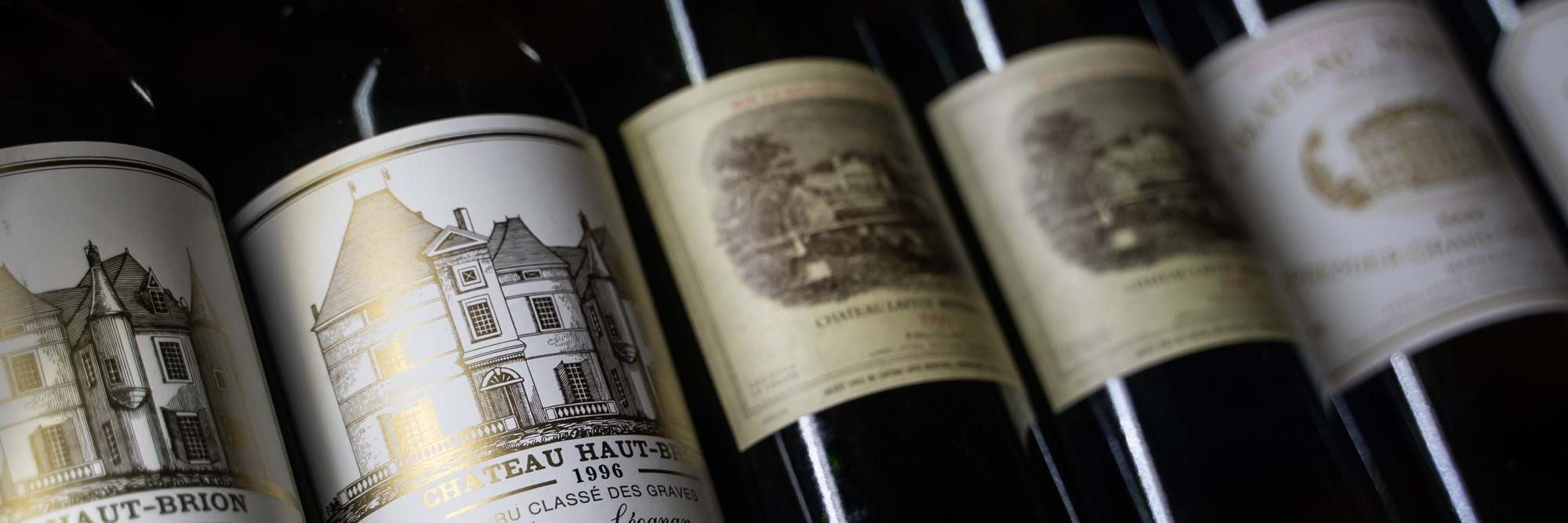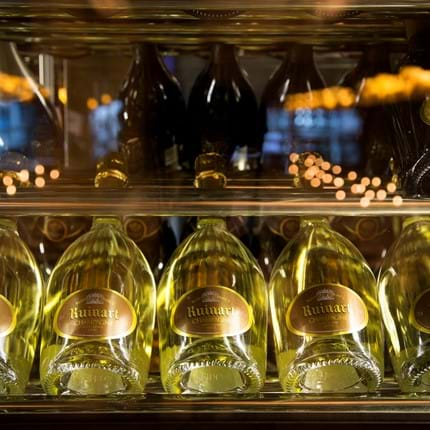
The Rhône Valley wine region is located in southeastern France, is one of the most celebrated and esteemed wine regions in the world. It stretches along the banks of the Rhône River (where it takes its name), from the city of Lyon in the north to the Mediterranean Sea in the south. The region is divided into two main sections: the Northern Rhône and the Southern Rhône, each with distinct characteristics and renowned wines that are famous in restaurants across the world.
The Northern Rhône is known for its steep hillsides, rugged terrain, and a cooler climate influenced by the mistral wind. This region primarily focuses on the production of red wines, particularly Syrah, which is the dominant grape variety here. Syrah from the Northern Rhône is highly regarded for its elegance, complexity, and ability to age. The appellations of Côte-Rôtie, Hermitage, and Cornas are among the most prestigious and sought-after in this area.
In contrast, the Southern Rhône boasts a warmer Mediterranean climate and is famous for its diverse range of red, white, and rosé wines. The region is renowned for its blended wines, often referred to as GSM (Grenache, Syrah, Mourvèdre) blends. Grenache is the most widely planted grape variety, contributing to the richness, warmth, and fruit-forward character of the wines. The Southern Rhône is home to the iconic Châteauneuf-du-Pape appellation, which produces bold, full-bodied red wines with intense flavours and aromas.
Moreover, the Rhône Valley maintains traditional winemaking techniques and long-standing viticultural heritage. The region's complex soils, ranging from granite and schist in the north to clay, limestone and pebbles in the south, offer distinct growing conditions that shape the flavours and styles of the Rhône Valley wines.
Rhône Valley wine at Beast
The Beast menu includes over 300 bins of exceptional wine, with several of the best Rhône Valley wines.
Crozes-Hermitage, Domaine Alain Graillot, Rhône Valley, France
One of our many favourites on the Beast menu is the Crozes-Hermitage, produced by Domaine Alain Graillot in the Rhône Valley, France, this bottle is a highly regarded wine that captures the essence of the Northern Rhône. This wine is made predominantly from the Syrah grape, which thrives in the region's granite and limestone-rich soils.
Crozes-Hermitage from Domaine Alain Graillot is known for its deep, ruby colour and vibrant, expressive flavours that pair perfectly with the steak offering at Beast. It offers an enticing mix of dark berries, black currants and spices, accompanied by hints of black pepper and violet. On the palate, you’ll experience a balance of fruit, acidity, and supple tannins, leading to a long and satisfying finish that compliments a rich steak perfectly.
Ermitage, Le Reverdy, Ferraton Père & Fils
Ermitage, Le Reverdy, produced by Ferraton Père & Fils, is a highly esteemed wine from the renowned Hermitage appellation in the Northern Rhône Valley, France. This wine exemplifies the exceptional quality and complexity that Hermitage is celebrated for. It is primarily crafted from Syrah grapes and displays a deep, garnet colour. In terms of flavour, you can expect a variety of dark fruits, such as blackberries and black cherries, intertwined with notes of spices, herbs, and a touch of smokiness. On the palate, it reveals layers of rich, concentrated flavours, supported by well-integrated tannins and vibrant acidity.
Condrieu, Jardin Suspendu, Pierre Jean Villa
Condrieu, Jardin Suspendu, crafted by Pierre Jean Villa, is a highly sought-after wine from the Condrieu appellation in the Northern Rhône Valley, France. This wine is exclusively made from the Viognier grape, a variety renowned for producing exquisite Rhône Valley white wines. Condrieu, Jardin Suspendu offers a pale golden hue and a subtle, aromatic profile. It offers a captivating bouquet of ripe peaches, apricots, tropical fruits, and delicate floral notes, such as honeysuckle and jasmine.
On the palate, you can expect a rich, velvety texture and a harmonious balance of fruitiness, minerality, and vibrant acidity. The wine's flavours unfold gracefully, with hints of citrus zest and a touch of spice adding complexity. Condrieu, Jardin Suspendu showcases the opulence, elegance, and purity of Condrieu's Viognier grapes, making it a highly popular choice for those seeking a sophisticated and balanced white wine experience.
Where is Rhône Valley?
The Rhône Valley is situated in southeastern France, along the banks of the Rhône River. It extends from the city of Lyon in the north to the Mediterranean Sea in the south. The region encompasses a wide area, covering approximately 125 miles from north to south.
The Northern Rhône is the uppermost section of the valley and starts around the city of Vienne, about 19 miles south of Lyon, and extends southward to Valence. The vineyards in the Northern Rhône are nestled on steep hillsides along the river, taking advantage of the exposure to sunlight and the moderating influence of the Rhône River. The wines in the northern part of the region match the scenery. Here you’ll find incredible, deeply coloured, spicy reds made from the notorious Syrah grape. As well as comparatively rich, full-bodied whites made from the Marsanne and Roussanne grapes
The Southern Rhône, contrastingly, begins near the city of Montélimar and continues all the way down to the region's endpoint at Avignon and Orange. It covers a larger area compared to the Northern Rhône, encompassing the famous Châteauneuf-du-Pape, Gigondas, and Vacqueyras appellations. The Southern Rhône benefits from a more Mediterranean climate and is characterised by rolling hills, vast plains, and plateaus.
Additionally, the Rhône River plays a significant role in shaping the region's viticulture, acting as a vital water source for irrigation and providing a partial influence on the local climate. The river also acts as a natural transportation route, which has facilitated the movement of goods and trade throughout history.
The history of Rhône Valley wine
The history of winemaking in the Rhône Valley can be traced back to ancient times, with evidence of grape cultivation and wine production dating back to the Roman era. The Romans recognised the region's favourable climate, fertile soils, and proximity to the Rhône River as positive circumstances to create some incredible Rhône Valley wine.
During the Roman occupation, the Rhône Valley became an important centre for wine production, with new grape varieties introduced and advanced winemaking techniques established in vineyards. Over time the vineyards began producing wine for both local consumption and trade throughout the Roman Empire.
After the fall of the Roman Empire, winemaking in the Rhône Valley continued, although it faced various challenges and fluctuations over the centuries. In the Middle Ages, the influence of the Catholic Church played a crucial role in developing the region's vineyards. In fact, many monastic orders contributed to the expansion and improvement of viticulture in the area; cultivating vineyards, improving vineyard management practices, and documenting their winemaking knowledge to share.
By the 17th century, the famous wines of the Rhône Valley were appreciated by European nobility. However, the region faced setbacks due to infestations and economic challenges in the 19th century. Namely, the phylloxera epidemic devastated vineyards across Europe, including those in the Rhône Valley, leading to the replanting of vineyards with grafted vines.
In the early 20th century, the establishment of the AOC (Appellation d'Origine Contrôlée) system in France brought structure and regulation to the wine industry. Through the AOC, the Rhône Valley gained official recognition for its quality wines, and various appellations within the region were classified and protected by specific production rules.
This system has helped ensure the authenticity and integrity of wines from the Rhône Valley. Over the years, the Rhône Valley has seen a resurgence in its reputation and popularity with Rhône Valley red and white wines making their way onto restaurant menus worldwide. Winemakers have embraced both traditional and modern winemaking techniques, focusing on expressing the unique terroirs and grape varieties of the region.
Best served at Beast
At Beast, wine and steak are at the forefront of your experience. From the moment you descend the stairs and embark on your journey through land and sea within our restaurant, you will remark on your experience.
With over 300 different types of wine held within our vault, including Piedmont and some of the best wines from the Rhône Valley, we are the perfect partner to take you on a flavourful journey. Our menu includes delicious starters and sides, and some of the most highly prized cuts of beef from across the land, such as Fuji Wagyu and Kobi Wagyu, incredible Porterhouse, and a blackboard of specialist cuts. If you’d prefer to venture into the sea, we offer some truly incredible seafood, including fresh Atlantic-caught King Crabs, fresh oysters and whole native lobster.
As you travel through the menu, allow our expert staff to guide you through the wine menu and try glasses, bottles and carafes from regions far and wide.


